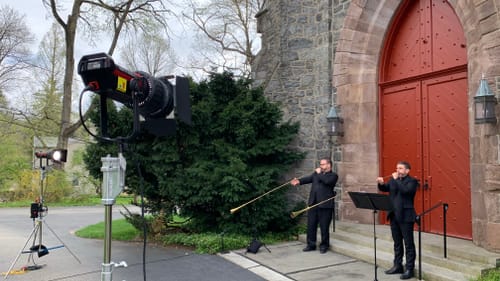Stay in the Loop
BSR publishes on a weekly schedule, with an email newsletter every Wednesday and Thursday morning. There’s no paywall, and subscribing is always free.
Fleeing to the music
Piffaro presents ‘Fuguing from Obrecht to Bach’

Musicians have long embraced the fugue, that musical chase whose interweaving melodic lines seem to coil around one another in endless possibilities. Composers continue to explore it, but for its last recorded concert of the season, Piffaro looks backward to the fugue’s golden age for another of its remarkable filmed explorations, Fuguing from Obrecht to Bach.
The Mid-Atlantic is a home for early music and musicians in large part because of the Renaissance band rooted in Philadelphia for more than 40 years. For Fuguing, six Piffaro players were joined by the five musicians of Kleine Kammermusik, another highly regarded Philadelphia early music ensemble, whose strings and keyboards enabled this history of contrapuntal music (by composers both familiar and less so) to span two and a half centuries. The musicians traveled to Wilmington, Delaware, where, on the grounds of historic Christ Church Christiana Hundred, these two ensembles explored the art of the fugue from the 15th to 17th centuries.
A musical jewel box
The film’s opening credits are underscored by a 16th-century pavane and views of the beautiful site and surrounding woods. At the church’s red entry doors, a fanfare for two gorgeous long trumpets announces the concert, which heads inside for an ingenious and complex fugue by the titular Jakob Obrecht (1457/8-1505). Throughout, flowing visuals (shot and sensitively edited by Sharon Torello) explore the historic church, and, in spite of challenges from the April weather, the audio (recorded by John C. Baker) is pristine and balanced.
As always with Piffaro, the concert is chock-full of wonderful music—19 compositions here—and it’s not possible to call out all the works and the consistent virtuosity of these players. Gems tumble one after another out of a musical jewel box, but here are some highlights that illustrate the variety and range.
Elegant, clear, haunting
A dramatically lighted harpsichord solo—the Praeludium by the great Dietrich Buxtehude (1637/39-1707)—is played with elegance and clarity by Kleine Kammermusik’s Leon Schelhase, whose virtuosity perfectly serves the composer’s exceptional writing and never occludes the clarity of the fugal lines. It’s directly followed by the joyous Goldberg Variation #30: Quodlibet by J.S. Bach (1685-1750) for portative organ, oboes, bassoon, and cello, after which comes the melancholy meditative Canzon “La Borga” for low winds by Costanzo Antegnati (1549-1624).
Another section pairs the glorious Bach Fugue in G minor, masterfully played by a wind quartet, with the Andante movement from Sonata IV by Jan Dismas Zelenka (1679-1747), a Bohemian contemporary of Bach who should have shared Bach’s reputation and visibility. He wrote challenging works rich in counterpoint, and though their paths never crossed, the two composers knew of one another, and Bach regarded Zelenka’s work very highly.
Then there’s a haunting solo rendition (Priscilla Herreid on the shawm) of the medieval chant Da pacem Domine. Echoing in the church’s outdoor labyrinth, each successive rendition of this melody adds more instruments. The chant morphs into eight successive interpretations of the hymn Verleigh uns Frieden (from the 15th to the 17th century) by some starry early music names—Praetorius, Schein, Schütz—and ends with a gorgeous chorale-like setting by Bach.

Flee, chase, and finish
Instruments abound: the 11 musicians play 21 different ones, some familiar (recorders, bassoon, harpsichord), others not so much (the remarkable curved oboe da caccia and the theorbo, a huge lute). (Piffaro’s instruments are highlighted in a Google Arts & Culture profile.)
Piffaro is also noted for taking Renaissance works that might be new to many listeners and bringing them vividly alive. Performances are based on considerable scholarship and research, and here, the double-barreled concert program includes not only a list of music and performers but also Piffaro cofounder Bob Wiemken’s 17-page treatise on the fugue.
While there is musical food for the historian, musicologist, and performer, there’s also melodic joy for the audience, exemplified by the concert’s finale, a marchlike work with an enormous title: Charivari from Le Mariage de la Grosse Cathos Suite by André Danican Philidor l’aine (c. 1652-1730). The moniker might sound intimidating, but when the entire company gathers with the additions of drums, it’s a delight for both viewers and musicians. At the work’s conclusion, the players break the concert’s fourth wall with glee and enthusiasm, talking to one another as they celebrate not only the end of the concert but the finale of an enormously challenging season.
The word “fugue” comes from the Latin fugere, which can be interpreted in two ways: either “to flee” or “to chase.” Listening to this music in such a gorgeous setting, it’s possible to do both—to chase the ever-changing music and flee to another time and place with open eyes and ears.
Image description: an outdoor photo of four Piffaro musicians playing wooden Renaissance-style instruments. They stand on a cobbled courtyard with a backdrop of blossoming spring trees.
Image description: A outdoor photo of a stone church’s red door with two Piffaro musicians standing on either side of it, playing Renaissance-style trumpets that are longer than their bodies.
What, When, Where
Fuguing from Obrecht to Bach. A ticketed virtual concert by Piffaro. Joan Kimball, Bob Wiemken, Priscilla Herreid, Grant Herreid, Greg Ingles, and Erik Schmalz; with guest artists Kleine Kammermusik (Geoffrey Burgess, Margaret Owens, Stephanie Corwin, Rebecca Humphrey, and Leon Schelhase). Recorded at Christ Church Christiana Hundred, Wilmington; available to stream through June 3, 2021. Information and tickets: 215-235-8469 or piffaro.org
Sign up for our newsletter
All of the week's new articles, all in one place. Sign up for the free weekly BSR newsletters, and don't miss a conversation.

 Gail Obenreder
Gail Obenreder